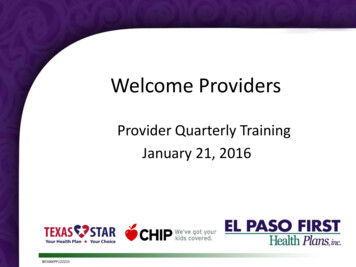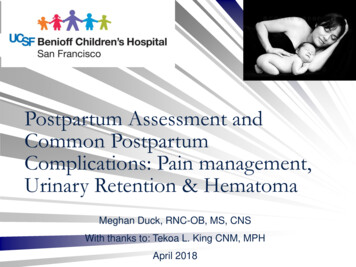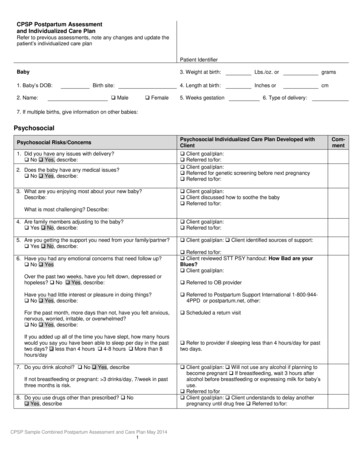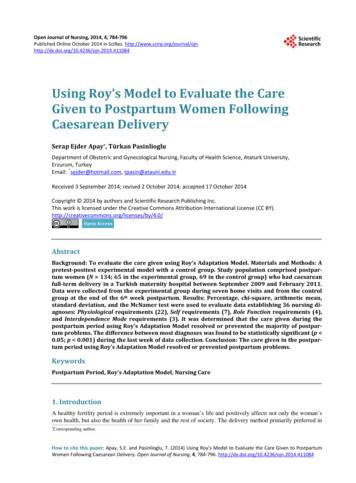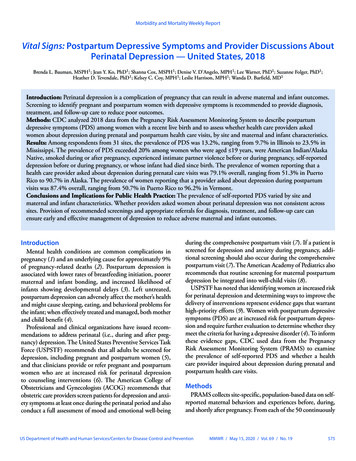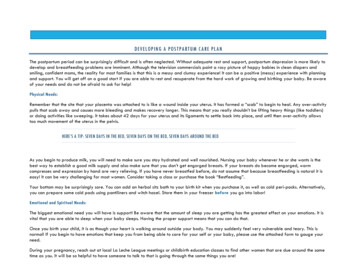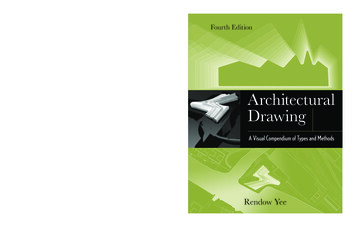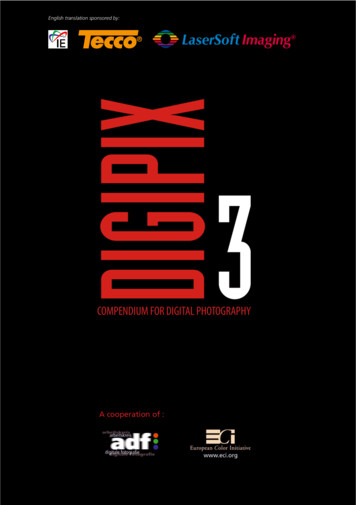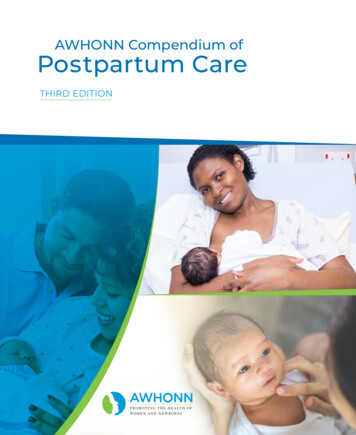
Transcription
AWHONN Compendium ofPostpartum CareTHIRD EDITION
AWHONN Compendiumof Postpartum CareThird EditionEditors:Patricia D. Suplee, PhD, RNC-OBJill Janke, PhD, WHNP, RN
This Compendium was developed by AWHONN as an informational resource for nursing practice. The Compendiumdoes not define a standard of care, nor is it intended to dictate an exclusive course of management. It presents generalmethods and techniques of practice that AWHONN believes to be currently and widely viewed as acceptable, based oncurrent research and recognized authorities. Proper care of individual patients may depend on many individual factorsto be considered in clinical practice, as well as professional judgment in the techniques described herein. Variations andinnovations that are consistent with law and that demonstrably improve the quality of patient care should be encouraged.AWHONN believes the drug classifications and product selection set forth in this text are in accordance with currentrecommendations and practice at the time of publication. However, in view of ongoing research, changes in governmentregulations, and the constant flow of information relating to drug therapy and drug reactions, the reader is urged to checkinformation available in other published sources for each drug for potential changes in indications, dosages, warnings,and precautions. This is particularly important when a recommended agent is a new product or drug or an infrequentlyemployed drug. In addition, appropriate medication use may depend on unique factors such as individuals’ health status,other medication use, and other factors that the professional must consider in clinical practice.The information presented here is not designed to define standards of practice for employment, licensure, discipline, legal,or other purposes.AWHONN Compendium of Postpartum Care, 3rd editionCopyright 2020 Association of Women’s Health, Obstetric and Neonatal Nurses. All rights reserved. This book is protected by copyright. This material may not be reproduced or transmitted in any form or by any other means, electronic ormechanical, including photocopy recording, without permission in writing from AWHONN.Recommended citation: Suplee, P.D. & Janke, J. (Eds.) (2020). AWHONN Compendium of postpartum care, (3rd Ed).Washington, DC: Association of Women’s Health, Obstetric and Neonatal Nurses.Requests for permission to use or reproduce material from this book should be directed to permissions@awhonn.org ormailed to: Permissions, AWHONN, Suite 740 South, 1800 M Street NW, Washington, DC 20036. Licensing of this titleis available for hospital or institutional libraries. Inquire at permissions@awhonn.org for pricing, terms and multi-titlepackages. *Licensing is only available for closed intranets or password-protected systems accessed by a limited and agreedupon range of users. Terms and conditions apply.Copyediting, design and graphic production provided by Customized Communications, Inc.ISBN: 978-1-938299-64-3AWHONN Product code: HC-CPC-012AWHONN Product code: DL-CPC-320i
AcknowledgementsThe AWHONN Compendium of Postpartum Care (3rd Edition) (Compendium), is a comprehensive reference book targetedprimarily to meet the needs of postpartum and mother-baby care nurses. This third edition was developed and updatedby a team of AWHONN member experts who are nationally and internationally recognized for their significant contributions in maternal, low-risk, high-risk, and neonatal intensive care nursing. The editors, contributors and reviewers wereselected for their expertise as clinicians, academicians, and researchers whose work is focused on improving the health andwell-being of women, newborns, and their families. AWHONN gratefully acknowledges their dedication and diligenceto ensure that the Compendium remains an essential evidence-based nursing resource.Ensuring uniformity in content and professional guidance across all of AWHONN’s education and practice resourcesis a fundamental principle of our work. As such, AWHONN has incorporated relevant content consistent with currentliterature and practice recommendations from a variety of sources, and from key AWHONN publications. In particular,content for this Compendium was adapted in part, from AWHONN’s Perinatal Nursing, (4th Edition), and from relevantAWHONN evidence-based clinical practice guidelines. We acknowledge and are grateful for the expertise and work ofthe editors, contributors, and reviewers for those publications.AWHONN honors the memory of Ms. Mary Ellen Boisvert, MSN, RN, CLC, CEE, whose review of this book representsonly a small view of her untiring dedication and service to AWHONN. Mary Ellen’s passion for her work, for life-longlearning and professional growth, and for her unflinching commitment to AWHONN’s mission, members, and her colleagues will be greatly missed.Editors:Patricia D. Suplee, PhD, RNC-OBJill Janke, PhD, WHNP, RNReviewers:Barbara Alba, PhD, RN, NEA-BCMary Ellen Boisvert, MSN, RN, CLC, CEEKatharine Donaldson, MSN, APN, C, WHNP-BC,RNC-OB, CPLC, C-EFMRobyn D’Oria, MA, RNC, APNEmily Drake, PhD, RN, CNL, FAANJoanne I. Goldbort, PhD, RNAnn C. Holden, RN, BSCN, MSC(T), PNCMarin Skariah, MSN, FNP-BC, RNC-MNN,C-EFM, IBCLCContributors:Cheryl Tatano Beck, DNSc, CNM, FAANLaura Griffith-Gilbert, MSN, RNC-OB, C-EFMJill Janke, PhD, WHNP, RNAnnie Rohan, PhD, RN, NNP-BC, CPNP-PC, FAANPJennifer B. Rousseau, DNP, WHNP-C, CNEPatricia D. Suplee, PhD, RNC-OBSusan VonNessen-Scanlin, DNP, MBA, MSN, CRNPAWHONN gratefully acknowledges Customized Communications, Inc. for the copyediting, design and graphic productionof this state-of-the-art education manual.800.476.2253 CUSTOMIZEDINC.COMii
PrefaceThe AWHONN Compendium of Postpartum Care (3rd Edition) (Compendium), provides essential information for nursescaring for women, infants, and families in the hospital, birthing center, out-patient, and home settings. This revised reference book provides evidence-based information and guidelines for postpartum care, addressing the physical, developmental,emotional, and psychosocial needs of mothers, newborns and families from birth through the first postpartum visit. Thisthird edition Compendium is reformatted by topic area for ease of access by the reader and includes the following chapters: Chapter 1:Chapter 2:Chapter 3:Chapter 4:Chapter 5:Assessment and Care of the Postpartum WomanAssessment and Care of the NewbornInfant FeedingMaternal and Infant Discharge Planning, Health Teaching, and Early HomecarePostpartum Mood and Anxiety DisordersMost women experience normal healthy pregnancies, therefore, much of postpartum nursing care and discharge preparation focuses on meeting mothers’ fundamental physical and psychosocial needs. However, maternal morbidity andmortality has emerged as a significant health care crisis in the United States. Each year, more than 700 women die frompregnancy-related causes, and the majority of these deaths occur during the postpartum period. The Compendium thirdedition includes expanded content on postpartum complications and highlights AWHONN’s POST-BIRTH WarningSigns parent education.Newborn care content includes updated evidence-based information for normal newborn care and discharge preparation,and a section focused on assessment and care of the late-preterm infant. A dedicated infant feeding chapter providescomprehensive, best practice information targeted to breastfeeding protection, promotion, and support. It also includesupdated guidance on formula preparation, use, and storage for mothers who cannot, or make informed decisions not tobreastfeed their newborns.Postpartum mood and anxiety disorders present a significant threat to both maternal and infant health. Sadly, in extremecases, these disorders can result in the death of the mother and her infant or her other children. The third edition featuresupdated research and practice recommendations for the spectrum of postpartum mood and anxiety disorders, and includesa series of case examples that helps to bring the mother’s view of these disorders into clear focus.Teaching mothers how to care for themselves and their infants at home is a key nursing role in promoting continuity of care.Nurses caring for postpartum women help to ensure that these women connect with primary care providers, out-patientservices, and community resources. Hospital-based nurses should be aware of relevant community resources, and nursespracticing in the community should be aware of best practices for continuing postpartum care and education when themother and infant are discharged.Each updated chapter includes a relevant case study and a resource list for further exploration by postpartum and mother-baby nurses, or to share with mothers during discharge preparation. Please visit AWHONN’s Healthy Mom and Babywebsite to access a wide variety of patient education resources at https://www.health4mom.org/As the Editors of this new edition of the AWHONN Compendium of Postpartum Care, our goal was to provide a comprehensive, user-friendly resource that has great value for all nurses who provide care for women during the postpartum period.We hope we have accomplished this goal for our readers.Patricia D. Suplee, PhD, RNC–OBJill Janke, PhD, RNiii
Table of ContentsChapter 1Assessment and Careof the Postpartum Woman . . . . . . . . . . . . . . 1Laura Griffith-GilbertJennifer B. RousseauTransition from Intrapartum to Postpartum Care . . . . . 1Handoff Process from Labor and Deliveryto Postpartum . . . . . . . . . . . . . . . . . . . . . . . . . . . . . 1Postpartum Physical Changes, NursingAssessments, and Interventions . . . . . . . . . . . . . . . . 2Immunizations . . . . . . . . . . . . . . . . . . . . . . . . . . . . . . . 5Physical Assessment and Care for WomenPost Vaginal Birth . . . . . . . . . . . . . . . . . . . . . . . . . . 6Perineal Care and Comfort Measures . . . . . . . . . . . . . 11Care for Women Post Cesarean Birth . . . . . . . . . . . . . 12Care of Women Who Have Received Epidural,Spinal Anesthesia, or General Anesthesia . . . . . . . .13Psychosocial Assessment . . . . . . . . . . . . . . . . . . . . . . . 14Parent-Infant Attachment . . . . . . . . . . . . . . . . . . . . . . 16Postpartum Complications . . . . . . . . . . . . . . . . . . . . . 20Cardiovascular Disease . . . . . . . . . . . . . . . . . . . . . . . . 26Conclusion . . . . . . . . . . . . . . . . . . . . . . . . . . . . . . . . . 29Resources . . . . . . . . . . . . . . . . . . . . . . . . . . . . . . . . . . 32Case Studies . . . . . . . . . . . . . . . . . . . . . . . . . . . . . . . 32References . . . . . . . . . . . . . . . . . . . . . . . . . . . . . . . . . 34Chapter 2Assessment and Careof the Newborn . . . . . . . . . . . . . . . . . . . . . 37Annie RohanAssessment and Care of the Newborn . . . . . . . . . . . . . 37Transition to Extrauterine Life . . . . . . . . . . . . . . . . . . 37Nursing Assessments . . . . . . . . . . . . . . . . . . . . . . . . . 41Focused Care for Common Infant Challenges . . . . . . . 58Substance Exposed Newborns . . . . . . . . . . . . . . . . . . . 65Infant Safety in the Hospital or Birthing Center . . . . . 70Resources . . . . . . . . . . . . . . . . . . . . . . . . . . . . . . . . . . 71Case Study . . . . . . . . . . . . . . . . . . . . . . . . . . . . . . . . . 72References . . . . . . . . . . . . . . . . . . . . . . . . . . . . . . . . . 72Chapter 3Infant Feeding . . . . . . . . . . . . . . . . . . . . . . 77Jill JankeInfant Feeding . . . . . . . . . . . . . . . . . . . . . . . . . . . . . . 77Infant-Feeding Decision . . . . . . . . . . . . . . . . . . . . . . . 77Benefits of Breastfeeding . . . . . . . . . . . . . . . . . . . . . . . 78Incidence of Breastfeeding . . . . . . . . . . . . . . . . . . . . . 78Baby-Friendly Hospital Initiative . . . . . . . . . . . . . . . . 81Breastfeeding Process . . . . . . . . . . . . . . . . . . . . . . . . . 83Breastfeeding Assessment . . . . . . . . . . . . . . . . . . . . . . 92Common Concerns . . . . . . . . . . . . . . . . . . . . . . . . . . 97Specific Concerns about the Neonate . . . . . . . . . . . . 102Formula Feeding . . . . . . . . . . . . . . . . . . . . . . . . . . . . 108Hospital Discharge . . . . . . . . . . . . . . . . . . . . . . . . . . 111Case Study . . . . . . . . . . . . . . . . . . . . . . . . . . . . . . . . 113References . . . . . . . . . . . . . . . . . . . . . . . . . . . . . . . . 113Chapter 4Maternal and Infant Discharge Planning,Health Teaching, and Early Homecare . . . 121Patricia D. SupleeSusan VonNessen-ScanlinMaternal and Infant Discharge Planning,Health Teaching, and Early Homecare . . . . . . . . 121Maternal Discharge Teaching . . . . . . . . . . . . . . . . . . 122Discharge Overview . . . . . . . . . . . . . . . . . . . . . . . . . 131Follow-Up Assessment and Postpartum Visit . . . . . . . 135Parent Education for Newborn Care and Safety . . . . . 142Conclusion . . . . . . . . . . . . . . . . . . . . . . . . . . . . . . . . 152Resource List . . . . . . . . . . . . . . . . . . . . . . . . . . . . . . 152Case Studies . . . . . . . . . . . . . . . . . . . . . . . . . . . . . . . 152References . . . . . . . . . . . . . . . . . . . . . . . . . . . . . . . . 154Chapter 5Postpartum Moodand Anxiety Disorders . . . . . . . . . . . . . . . 157Cheryl Tatano BeckPostpartum Blues . . . . . . . . . . . . . . . . . . . . . . . . . . . 158Postpartum Depression . . . . . . . . . . . . . . . . . . . . . . . 158Implications for Nursing Practice . . . . . . . . . . . . . . . 170Bipolar II Disorder with Peripartum Onset . . . . . . . . 171Postpartum Psychosis . . . . . . . . . . . . . . . . . . . . . . . . 172Obsessive-Compulsive Disorder in thePostpartum Period . . . . . . . . . . . . . . . . . . . . . . . 173Panic Disorder . . . . . . . . . . . . . . . . . . . . . . . . . . . . . 174Posttraumatic Stress Disorder . . . . . . . . . . . . . . . . . . 175Mothers’ Voices on Traumatic Birthand its Long-Term Impact . . . . . . . . . . . . . . . . . 177Conclusion . . . . . . . . . . . . . . . . . . . . . . . . . . . . . . . . 183Case Study . . . . . . . . . . . . . . . . . . . . . . . . . . . . . . . . 186References . . . . . . . . . . . . . . . . . . . . . . . . . . . . . . . . 187Index . . . . . . . . . . . . . . . . . . . . . . . . . . . . 191iv
IndexNOTE: Page numbers for figures are indicated by f and tables by t following the page number, e.g. 38f; 39t.AAAP. See American Academy of Pediatrics (AAP)abdomen and gastrointestinal system, 51–52,52t–53tabdominal relaxation, postpartum, 4ACOG. See American College of Obstetricsand Gynecology (ACOG)acrocyanosis, in newborn, 45active listening, 14activities of daily living, return to, 124adaptive parenting, 17–19adolescent parenting, 19Advisory Committee on ImmunizationPractices (ACIP), 40afterpains, 12, 102Agency for Healthcare Research and Quality(AHRQ), 165American Academy of Pediatrics (AAP)Breastfeeding and the Use of HumanMilk, 108developmental milestones, infant, 150, 151thyperbilirubinemia managementguidelines, 68–69screening for postpartum depression, 168American College of Obstetrics andGynecology (ACOG)immunization during postpartum period(toolkit), 132–134fparadigm shift for postpartum care, 122,123f, 135, 135t–136ton screening for mood and anxietydisorders, 168Americans with Disabilities Act (ADA), 2analgesics, postpartum, 124ankyloglossia (tongue-tie), breastfeedingassessment, 94, 94fanticipatory guidancedischarge criteria, 131, 150home visit and, 150mood and anxiety disorders, 185antidepressantsSSRI. See selective serotonin reuptakeinhibitors (SSRIs)tricyclic, 66t, 164anus, patent, 52anxiety disorders. See mood and anxietydisorders, postpartumApert syndrome, 47Apgar score, 37, 38f, 69apnea, in late-preterm infant, 63artificial nipples, 101Association of Women’s Health, Obstetric andNeonatal Nurses (AWHONN)assessment and care of late preterm infants,18, 60parent education and discharge planning, 64postpartum hemorrhage stages algorithm,24f–25fscreening for mood and anxietydisorders, 168asymmetrical breasts, 94attachment behaviors, delayed, 16auditory brainstem response (ABR), 48BBabinski reflex, 57baby blues (postpartum blues), 14, 158Baby-Friendly Hospital Initiative (BFHI)Baby-Friendly USA facilities, 81–82as evidence-based breastfeeding initiative, 81staff training, importance of, 82–83ten steps to successful breastfeeding(display), 82–83written breastfeeding policy, 82Baby-Friendly USA (BFUSA), 81Ballard Maturational Score (BMS), 43Barlow maneuver, 55, 55fbathing infantchecking temperature of bath water, 145colic and, 146parent education, 143predischarge review with mother, 137skin-to-skin contact and, 105support of head and neck,demonstrating, 145thermoregulation and timing of bath, 39,39t, 62umbilical care and, 52bed-sharing, precautions, 146–147behavioral cues, infant, 16bilirubin, in newborns, 106bilirubin encephalopathy (kernicterus), 148biological nurturing (laid-back hold), 87f, 88Indexbipolar II disorder with peripartum onsetDSM-5 criteria for, 171as postpartum depression impostor, 171treatment, 172birth control and family planningchild spacing, 127–128contraception, postpartum, 4contraceptive methods, 128–130,129t–130tcultural considerations, 130–131ovulation and menstruation, resumptionof, 127birth trauma. See traumatic childbirthbisphenol A (BPA), 109bladder, physical assessment, 8blood loss during childbirth, 3blood volume, postpartum, 3body image, 127bonding process, 16bottle feeding. See formula feedingbottle mouth syndrome, 111bowel, physical assessment, 8bowel sounds, newborn, 52breastasymmetrical breasts, 94breast care instructions, 124infections, 99massage, 99physical assessment, 7, 124pregnancy hormones and lactationprocess, 83risk factors for successful breastfeeding, 94support for breastfeeding, 88, 88fbreast milk jaundice, 106breast pumps and pumping, 102breastfeedingassessment. See breastfeeding assessmentBaby-Friendly Hospital Initiative, 81–83barriers to, 79basics, 90–92benefits, 78concerns about. See breastfeeding concernscontraindications, 79–80, 80tdelaying onset of type 2 diabetes, 27–28education, timing of, 77elimination pattern, newborn, 92, 100feeding frequency, 90, 90f191
growth spurts and, 90guidelines in neonatal abstinencesyndrome, 67Healthy People 2020 goals, 81, 81thospital discharge instructions andsupport, 111hunger cues, 86, 90, 91fincidence, 78–81interventions promoting, 77–78marijuana contraindicated in, 65milk transfer and satiation, 92minimizing postpartum blood loss, 21postpartum PTSD and, 180, 180fprocess. See breastfeeding processprofile of breastfeeders, 78–79psychopharmacology and, 165resources, 112breastfeeding assessmentassessment instruments, 95, 95t–96tcontraindications and risk factors forbreastfeeding, 93–94LATCH charting system, 95, 95tmaternal history and physical assessment,93–94neonatal assessment, 94Preterm Infant Breastfeeding BehaviorScale (PIBBS), 95breastfeeding concernsafterpains, 102blocked ducts, 99candida infections, 99–100cesarean birth, 107engorgement, 97–99, 98fhyperbilirubinemia, 106infant considerations, 106inhibited let-down, 101–102insufficient milk, 100–101, 113(case study)late-preterm birth, 107mastitis, 99maternal considerations, 106–108maternal fatigue, 106–107milk expression, 98, 98f, 102neonatal hypoglycemia, 106nipple shape, 97nipple soreness, 97pacifiers and artificial nipples, 101preterm birth, 107–108reluctant nurser, 102–103supplemental feedings, 101breastfeeding process, 83–92breast support, 88, 88fburping, 89, 89fcluster feedings, 86–87, 90early feedings, 84–85feeding positions, 87–88, 87fhuman milk, biospecificity of, 84initiation, 84–87lactation physiology, 83–84latch-on, 88–89, 88fmechanics of, 87–89192mismanagement and milkinsufficiency,100–101prefeeding behaviors, 85rousing newborn for feeding, 105skin-to-skin contact, 84–86supplemental feedings and breast milkdecrease, 85, 101brexanolone, 165brief psychotic disorder with peripartum onset(postpartum psychosis), 172–173BUBBLE-LE (physical assessment), 7burn prevention, infant, 145burping, breastfeeding and, 89, 89fCCandida albicans infections, 99–100caput succedaneum, 47, 47fcar seatspreterm infants and, 145safety issues, 148screening and testing, 141–142, 145cardiac decompensation, 27cardiomyopathy of pregnancy, 26–27cardiovascular disorders, 26–27cardiovascular systemabnormal findings, neonatal, 51tcyanotic congenital heart disease, 51heart murmurs, neonatal, 50newborn assessment, 50–51, 51tpostpartum changes, 3care plan outcomes (discharge criteria), 131carrying newborn, demonstrating, 145Centers for Disease Control and Prevention(CDC)hepatic B virus preventionrecommendations, 40immunization recommendations forinfants and children, 143, 144tcentral cyanosis, in newborn, 45cephalohematoma, 47, 47fcerebrovascular accident (CVA), postpartum, 28cervix, postpartum assessment, 9cesarean birthbowel sounds, monitoring, 8breastfeeding concerns, 107general anesthesia, 13–14HIV-1-infected women, recommendationfor, 41incisions, types of, 12fpostoperative complications, 13postpartum care, 12–13, 124respiratory morbidity in late-preterminfant, 62–63surgical site infection, 27child abuse and neglect, adolescent parent riskof, 19child development, postpartum depressioneffect on, 163child safety gates, 146child spacing, 127–128Chlamydia trachomatis, 39Indexchoking hazards, 145, 146cigarette smoking, in pregnancy, 65circumcision care, 53dcircumoral cyanosis, in newborn, 45City Birth Trauma Scale, 182clavicle injury, assessment of, 54club foot (talipes equinovarus), 55–56, 56fcluster feedings, 86–87, 90, 100cocaine use in pregnancy, 65cognitive behavioral therapy (CBT)postpartum depression, 164postpartum OCD, 174PTSD, 182cold therapy (ice pack), 11colic, 146colostrum, 84, 107comfort care, neonatal abstinence syndrome, 67communication analysis, 164complementary and alternative medicine, forpostpartum depression, 165compulsions, 173congenital anomalies, 18, 70congenital heart disease, critical (CCHD),141, 142fcontraception, postpartum. See birth controland family planningcortisol, 85Council on Patient Safety in Women's HealthCare, 185tcouple relationship, birth-related PTSD and,181–182Couzon syndrome, 47crackles (rales), 50craniostenosis, 47, 47fcrepitus, 54cribs and bedding, 146critical congenital heart disease (CCHD),141, 142fcryptorchidism (undescended testes), 54cuddle time, upright, 148cultural considerations, 121, 130–131cutis marmorata (mottling), 46cyanosis, newborn, 45cystic fibrosis screening, 138Ddeep vein thrombosis (DVT), 11, 28dental caries, 111desipramine, 164developmental dysplasia of hip (DDH),55, 55fdevelopmental milestones, infant, 150, 151tdevelopmental reflexes, 57, 57t–58tdiabetes, 28–29. See also hypoglycemia, neonataldiaphoresis, postpartum, 5diastasis recti, 4dietary supplements, postpartum depressionand, 165
discharge planning, 122–134. See alsofollow-up visit and assessment,postpartum; maternal health education;parent educationoverview, 121–122access to follow-up care, 142breastfeeding instruction and support, 111car seat screening and testing, 141–142criteria for discharge, 131cultural considerations, 121environmental and social support forinfant, 138home visits, 149immunizations, 131, 132–134flanguage of written materials, 122, 142late-preterm infant, 64maternal support and care team,identification of, 122Medicaid coverage, confirmation of, 123post-discharge residence, confirmationof,122postpartum well visit, scheduling,122, 123freferrals to care providers and agencies,122–123resource list, 152diuresis, postpartum, 3donor human milk, 101, 108double-volume exchange transfusion, 69drug therapy, for postpartum depression,164–165drug use in pregnancy, effects on fetus, 65dysuria, 8Eears, examination of, 48ecchymosis (bruising), 45–46e-cigarettes, preterm birth and low-birthweight infants, 65eclampsia, 26Edinburgh Postnatal Depression Scale (EPDS),165, 167–168, 167t, 168telectrical outlets, childproof covers for, 146electroconvulsive therapy (ECT), 173electronic medical record (EMR), predischarge review, 122EMDR (eye movement desensitization andreprocessing), 182emotional health (discharge criteria), 131emotional lability, in postpartum blues, 158encephalopathy, bilirubin, 148endocrine system, postpartum changes, 4engorgement, breastcauses and complications, 97–99manual expression of breast milk, 98, 98fon-demand breastfeeding, 98EPDS (Edinburgh Postnatal Depression Scale),165, 167–168, 167t, 168tepidural anesthesia and analgesia, 13epinephrine and milk supply, 100episiotomypostpartum assessment, 9–10REEDA scoring, 9–10, 10ttypes of incisions, 9fEpstein's pearls, 48Erikson theory of psychosocial development, 19erythema toxicum (“newborn rash”), 46estrogen, 83evoked otoacoustic emissions (OAE), 48exchange transfusion, for hyperbilirubinemia, 69exercise, postpartum, 127, 165eye examination, newborn, 48, 48teye movement desensitization and reprocessing(EMDR), 182eye protection, phototherapy and, 69Ffall prevention, infant, 145family, postpartum depression and, 162family and social supportfollow-up visit assessment of, 136late-preterm infant and dischargeplanning, 64pre-discharge assessment of, 138family planning. See birth control and familyplanningfamily-centered care practices, 18fatherspostpartum depression in, 162, 163traumatic childbirth and, 183fatigue, postpartum, 16, 106–107feedback inhibitor of lactation (FIL), 101–102feeding frequency, 90, 90ffeeding positions, 87–88, 87f, 111fetal alcohol syndrome (FAS), 65Finnegan Scoring System, modified, 67ffloppy (hypotonic) infant, 56folic acid, 70follow-up care, access to, 142follow-up visit and assessment, postpartumACOG paradigm shift for scheduling, 122,123f, 135, 135t–136tcomponents of, 135t–136tdischarge planning, 142family and social support assessment, 136health education topics, 135–136importance of, 122formula feedingamount and schedule of feedings, 110–111equipment, 109feeding positions, 111formula preparation, 110hunger and satiety cues, 111inadequate parental education about, 108indications for, 108lactation suppression, 108–109mechanics of, 109–111preparation of formula, 108responsive feeding, 111sterilization of equipment, 109Indextypes of formula, 109water safety in formula reconstitution,109–110frenoplasty, 94, 94ffundal massage, 7Ggastrointestinal systemlate-preterm infant feeding challenges, 63newborn assessment, 51–52postpartum changes, 3gay and lesbian parents, 19–20genitourinary systemabnormal findings, neonatal, 54tnewborn assessment, 52–54penis and circumcision care, 53gestational age, 43–44, 44fgestational diabetes mellitus (GDM), 28–29.See also hypoglycemia, neonatalgestational hypertension, 26glucose metabolism, skin-to-skin contact and, 84group B streptococcus (GBS), in neonatalsepsis, 59growth spurts, breastfeeding and, 90, 100Hhair loss, postpartum, 5handoff communicationsJoint Commission recommendations, 1labor and delivery to postpartum unit, 1–2preparation to receive mother, 2handwashing, infection control and, 145harlequin sign, 46head examination, infantabout, 46–47birth defects, 47fbones, sutures, and fontanelles, 46fears, 48eyes, 48, 48theadache, postpartum, 4health education, postnatal. See maternalhealth educationhealth insurance, maternal/newborn hospitalstay standards, 121Healthy People 2020, breastfeeding goals,81, 81thearing screening, infant, 48heart disease, cyanotic congenital, 51heart murmurs, in newborns, 50HELLP syndrome, 26hematocrit, postpartum, 3hematologic system, postpartum changes, 3hematoma, perineal, 10hemorrhage, postpartumcauses and risk factors, 20–21checklist for, 22f–23fin complicated recovery (case study), 33hemorrhage stages algorithm, 24f–25fminimizing risk, 21quantification of blood loss, 21futerine atony and, 21193
hemorrhoids, postpartum perineal assessment,10–11hepatitis B vaccination, 5, 40hip instability, 54–55HIV infections, 41holding newborn, demonstrating, 145Homan's sign, 11home visits, post-discharge, 149Human Milk Banking Association of NorthAmerican, 101hunger cuesbreastfeeding and, 86, 90, 91f, 100formula feeding, 111hydrocele, 54hyperbilirubinemiabreastfeeding and, 106exchange therapy, 69incidence and mechanisms, 68late-preterm infant, 62management guidelines, 68–69phototherapy, 69prevention and management, 148–149risk factors, 68, 68thypertelorism, 48hypertensive disorders of pregnancy, 25–26hypoglycemia, neonatalbreastfeeding and, 106early feeding and, 40glucose homeostasis screening, 40, 41fglucose metabolism and skin-to-skincontact, 84late-preterm infant, 61dneonates at risk for, 40tprevention and management, 40hypomania, 171hypoplastic breasts, 94hypospadias, 54hypotelorism, 48hypothermia, late-preterm infant, 61, 62hypothermia therapy, 69hypotonic infant (hypotonia), 56, 141hypovolemia, 21hypoxic-ischemic encephalopathy (HIE), 69Iice pack, postpartum, 11identification, infant, 70immunizationsCDC recommendations, 144tparent education, 143postpartum, 5–6, 131, 132–134fincubation, thermoregulation and, 39infant abduction prevention, 71, 145infant feeding, 77–113. See also breastfeedingformula feeding, 108–111late-preterm infant, challenges of, 63maternal decision making, factors in,77–78neonatal weight loss, 105–106, 105fnurses' role in, 77, 78reluctant nurser, 102–103194resources, 112responsive feeding, 111supplemental feedings and breast milkdecrease, 85, 101infant identification, 70infant safetyinfant identity verification, 70, 145parent education, 143, 145preventing abduction, 71safe sleep, 71, 71t, 147–148safety measures, generally, 145skin-to-skin care and, 86infant state, characteristics, 42tinfanticide, postpartum psychosis and, 172infection control, parent education, 145innocent murmurs, cardiac, 50integumentary system, postpartum changes, 5interpersonal psychotherapy (IPT), 164inverted nipples, latch-on and, 88isch
iii Preface The AWHONN Compendium of Postpartum Care (3rd Edition) (Compendium), provides essential information for nurses caring for women, infants, and families in the hospital, birthing center, out-patient, and home settings. This revised refer-ence book provides evidence-based information and guidelines for postpartum care, addressing the physical, developmental,

